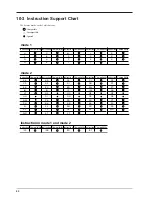
57
Are the blank areas due to the specifica-
tions?
Mechanical limitations produce margins at the front, back, left, and right of the
material. (Refer to “5-2 Details of the Origin-point Location and Cutting Area.”)
Blank areas are produced on the material
Is the length 1.6 m (63 in.) or longer?
Attempting to set up flat material having a length of 1.6 m or longer as [PIECE]
causes the material to be recognized as roll material. (Refer to “5-2 Details of the
Origin-point Location and Cutting Area.”)
Flat material cannot be set up as "PIECE" (the length is not displayed)
Is a material with sprocket holes being
used?
If a material with holes for sprocket feed is being used, placing the pinch roller
above the hole portion may cause the material to slip. Be sure to set the pinch
roller over the material to the inner side of the hole portion.
The Material slips away from the pinch rollers during the cutting process
If a flat material (such as a standard-size
material or piece material) has been
loaded, has the “PIECE” setting been
selected for the material type?
When loading the material, select [PIECE] for the [SELECT SHEET] display
menu (refer to “5-4 Loading Flat Material (Standard-size Material, Cut Material,
Etc.)”).
Is the material being cut blocked at
some position?
Make sure that the left and right edges of the material do not touch the inner
surfaces, the shafts of the CX-500/400/300 during cutting. Such contact may not
only damage the material, but could also make normal material advancing
impossible and cause the material to slip.
Is the material being cut loaded
straight?
If the front edge of the material you are working with is at an angle, cut off the
odd-shaped part to make it straight, then align it so that it is parallel with the grit
roller.
If the material is fed for a long distance, the material will be less likely to slip out
of alignment if the pinch rollers are moved inward slightly (5 to 25 mm).
When a roll material is loaded, use the display menu [AREA MOVE] function to
feed a material by the length to be used (ensure a small margin by setting a length
that is about 0.1 m longer than the cutting data), make sure the pinch rollers are
still in contact with the material (not off the left or right edges, or on the edges),
and then cut.
If the material is pulled while cutting it is more likely that material misalignment
and motor errors will occur.
Are the sheet loading levers lowered?
The material is not secured in place. Make sure the left and right pinch rollers are
inside the edges of the material, then raise the sheet loading levers.
Are the pinch rollers damaged or
deformed?
If the material comes loose even when it is loaded correctly, the useful life of the
pinch rollers has ended. If this happens, contact your authorized Roland DG Corp.
dealer. Replacement is a charged service operation.
Also, when you are not performing cutting, leave the sheet loading levers lowered
and the pinch rollers raised.
Summary of Contents for CX-300
Page 21: ...21 POWER ERROR LED goes out 4 Turn off the power ...
Page 63: ...63 MEMO ...
Page 64: ...R5 020403 ...
























